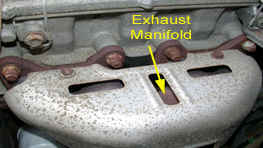
Description: Made of cast iron or tubular steel, the exhaust manifold mounts to the exhaust side of the cylinder head. An exhaust manifold gasket is used at the connection to ensure a good seal. Engines with their cylinders arranged in-line usually have one exhaust manifold. Engines with V-type cylinder arrangements, like the V6 and V8, have two separate exhaust manifolds, one mounted to each cylinder head.
Purpose: The exhaust manifold routes the exhaust gases leaving the cylinder head to the exhaust system. As such, the manifold also serves as a connection point for the exhaust pipe. Depending on engine configuration and the number of exhaust manifolds, there may be two exhaust pipe connections. Depending on the year, make and emissions equipment installed on the vehicle, the exhaust manifold may also serve as a mounting location for hardware of the air injection system or for an oxygen sensor. Also, some exhaust manifolds may still include a heat riser valve, controlled by a temperature-sensitive spring. This valve is designed to help divert hot exhaust gas through a separate passage in the intake manifold to aid in better warm-up driveability.
Maintenance Tips/Suggestions: Although not commonly replaced with other exhaust system parts, exhaust manifolds should be checked periodically to ensure they are tight, free from cracks, and that the exhaust pipe mounts are secure. A ticking noise during acceleration or the sound or smell of leaking exhaust could indicate a leak at the manifold or its connections. However, don't rely on your sense of smell as a conclusive means of determining if there's an exhaust leak. Carbon monoxide has no odor. If you suspect any problem with the exhaust system, have it inspected immediately by a professional technician. Another symptom of a potential exhaust leak is a failed emissions test. A leak not only lets exhaust gas out, it also allows oxygen to enter the exhaust stream, which can be detected during an emissions test. You will usually be required to make repairs before retesting, so have the leak checked by a professional technician.

